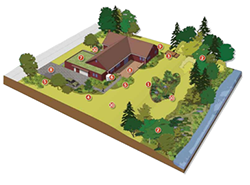Planning and Development Services
www.skagitcounty.net/stormwaterpermitting |
Key Concepts |
|||
|
|||
Application RequirementsSkagit County’s stormwater management requirements differ depending on whether you’re inside or outside the NPDES Permit Area. |
Stormwater Site Plan Requirement Most application may use our model. Review the form to see if you qualify, and submit the form with your application. If your project does not qualify, prepare a Construction SWPPP consistent with Stormwater Management Manual Minimum Requirement 2; see Volume II, Chapter 3 for guidance. Construction Stormwater General Permit |
||
|
| MR1 Stormwater Site Plan MR2 Construction Stormwater Pollution Prevention Plan (SWPPP) MR3 Source Control MR4 Preserve Natural Drainage |
MR5 Onsite Stormwater Management MR6 Treatment MR7 Flow Control MR8 Wetlands Protection MR9 Operations & Maintenance |
VIDEO
Site Plan Review Training hosted by the City of Anacortes Stormwater Management Program on November 17, 2020. Douglas C. Howie, P.E., Senior Stormwater Engineer from the Washington State Department of Ecology, presented to stormwater staff from local jurisdictions on the updated, 2019 Stormwater Management Manual for Western Washington (SWMMWW)
Stormwater Site Plan Review Training from Skagit County on Vimeo.
 |
| Photo: Rain Dog Designs, Gig Harbor, WA |
Low-Impact Development (LID)
Low-Impact Development techniques mimic natural processes to manage stormwater, and are frequently cheaper and more attractive than traditional stormwater management techniques.When is LID required?
LID is the preferred approach to stormwater management countywide. Inside the NPDES Permit Area and the Special Flood Hazard Area, LID techniques are required unless the Administrative Official determines the techniques as not feasible.
LID Techniques
For specifics on implementing techniques, see the Low Impact Development Technical Guidance Manual for Puget Sound (2012, 18mb PDF).
Resources
Open a new FSE; remodel or become a new operator of an existing FSE
If you plan to open a new food business, or remodel your permitted kitchen or take over an existing food service, you must submit plans for review. If your planned business is mobile or temporary, see the specific links elsewhere on this site.
- Plan Review Application
- The state food code governs the requirements for food facilities.
Mobile Food Service or Food Cart
A mobile food operation has special requirements. It must be on wheels and easily movable. An approved commissary or support kitchen is required. Menu and food preparation may be limited. Mobile units must be approved by Washington Department of Labor and Industries prior to operating. Contact Labor and Industries
Food Bank or Soup Kitchen
Food Banks provide a valuable service to our citizens in need. The Health Department does not charge a permit fee for these facilities, but we appreciate having contact information. We also can provide advice and information on safe food handling of donations and distribution.




















 Stormwater Permitting
Stormwater Permitting